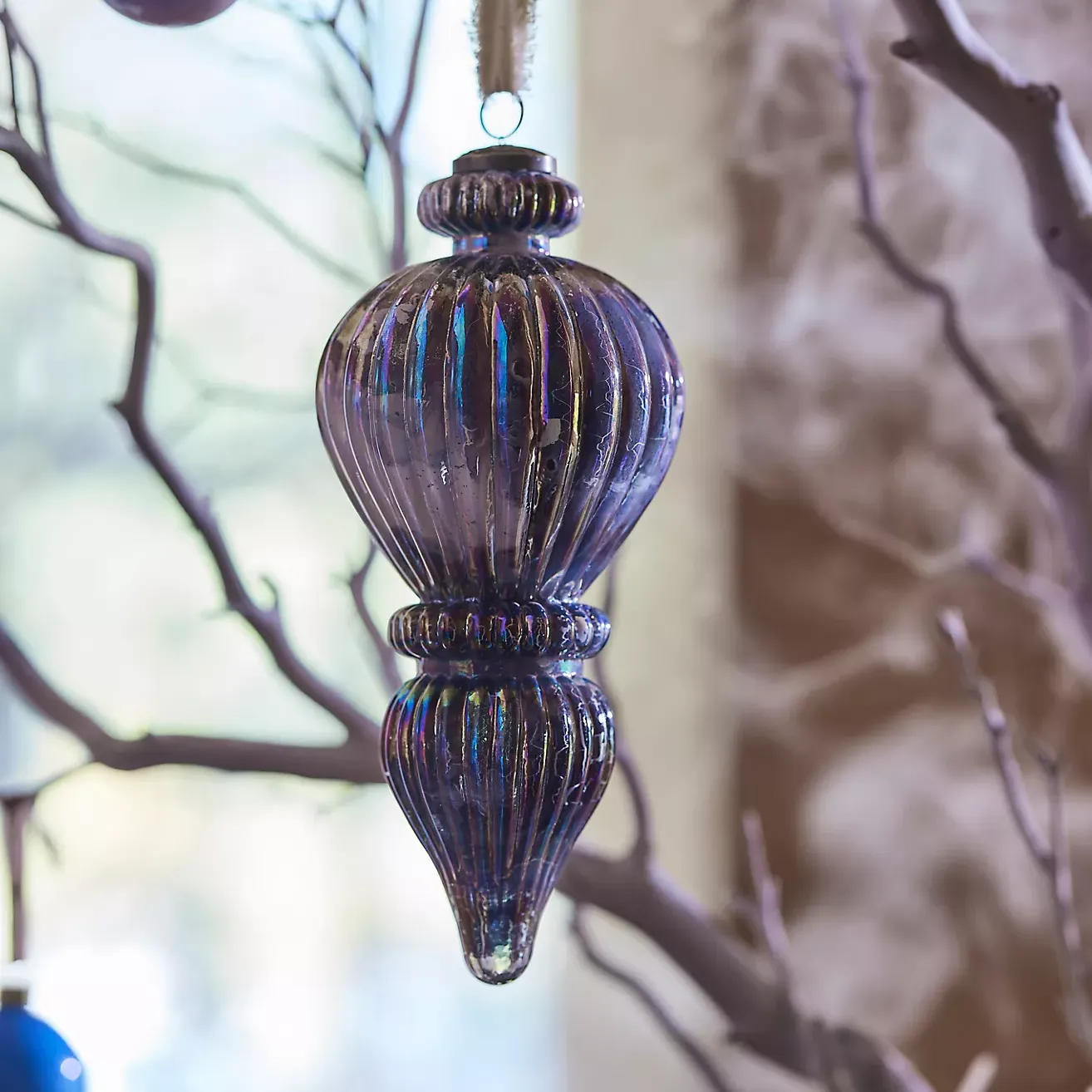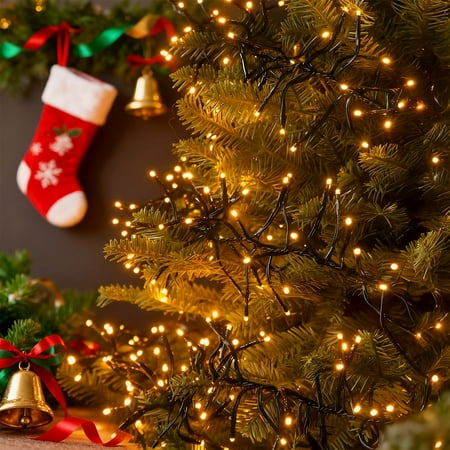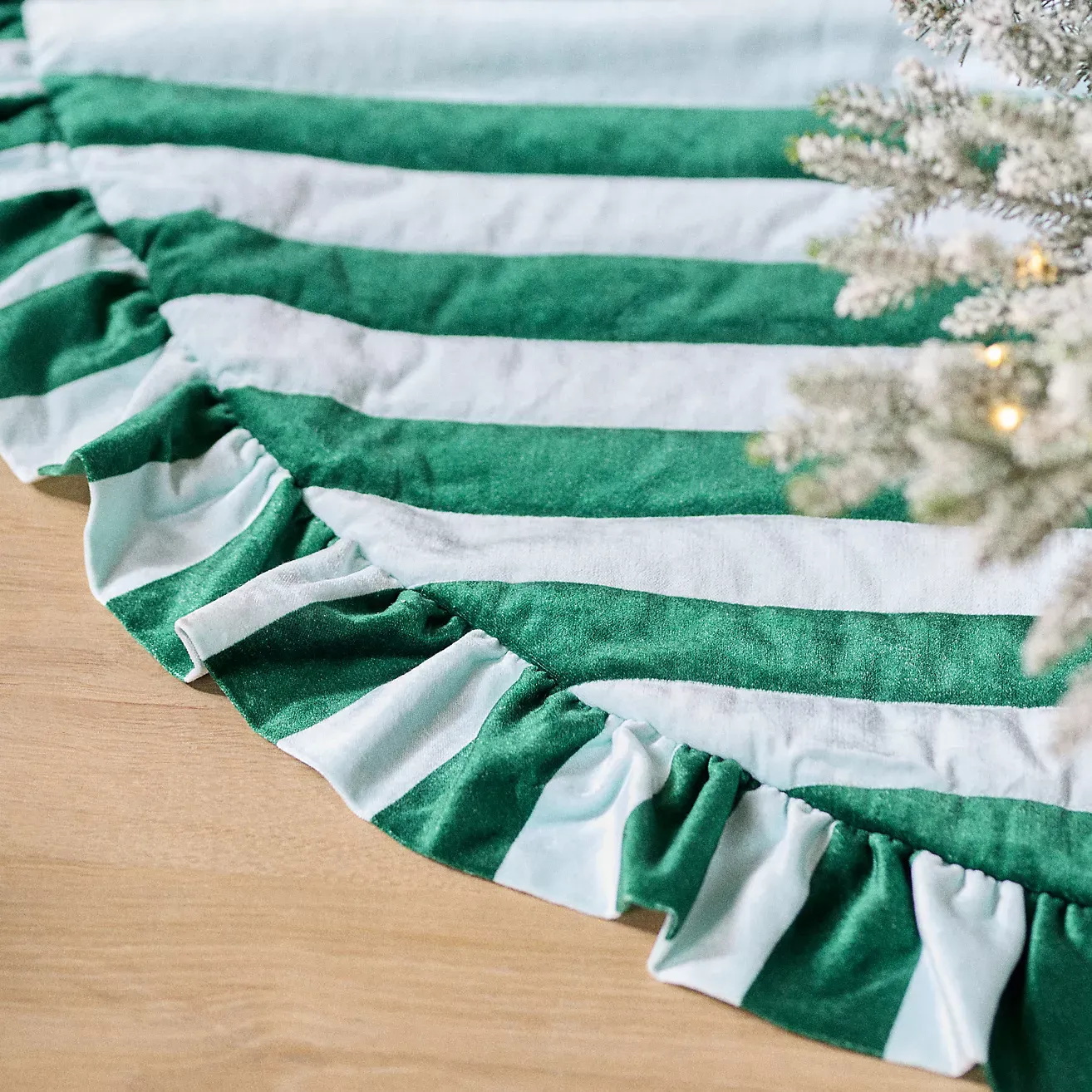How to Care for a Christmas Tree – Your Ultimate Guide to a Lush, Long-Lasting Holiday Centerpiece
From choosing the right tree, to prolonging its display, and what to do with it after the holidays, here's everything you need to get the most out of this festive staple


- How to choose the right Christmas tree
- Transporting your Christmas tree home
- What to do when you get your tree home
- Watering your Christmas tree
- How to stop your Christmas tree from drying out
- 6. How to keep your Christmas tree smelling fresh
- What to do with your Christmas tree after the holidays
- FAQs
Can it really be Christmas without a tree? The ritual of choosing the perfect size and shape; the excitement of bringing it home; the nostalgia of unboxing all your baubles and placing them on each scented branch. This magic epitomizes the start of the holidays for so many of us.
That being said, having a tree that is drooping, lasts a week before dropping needles, or goes brown can put a downer on festivities. Luckily, we have several tricks up our sleeve on how to care for a Christmas tree to keep it in top condition for the whole holiday season – and beyond.
Our ultimate guide is here to help you out, with insight from tree care experts on all things Christmas tree maintenance, so you can bring your biggest and brightest Christmas tree ideas to life this holiday season.
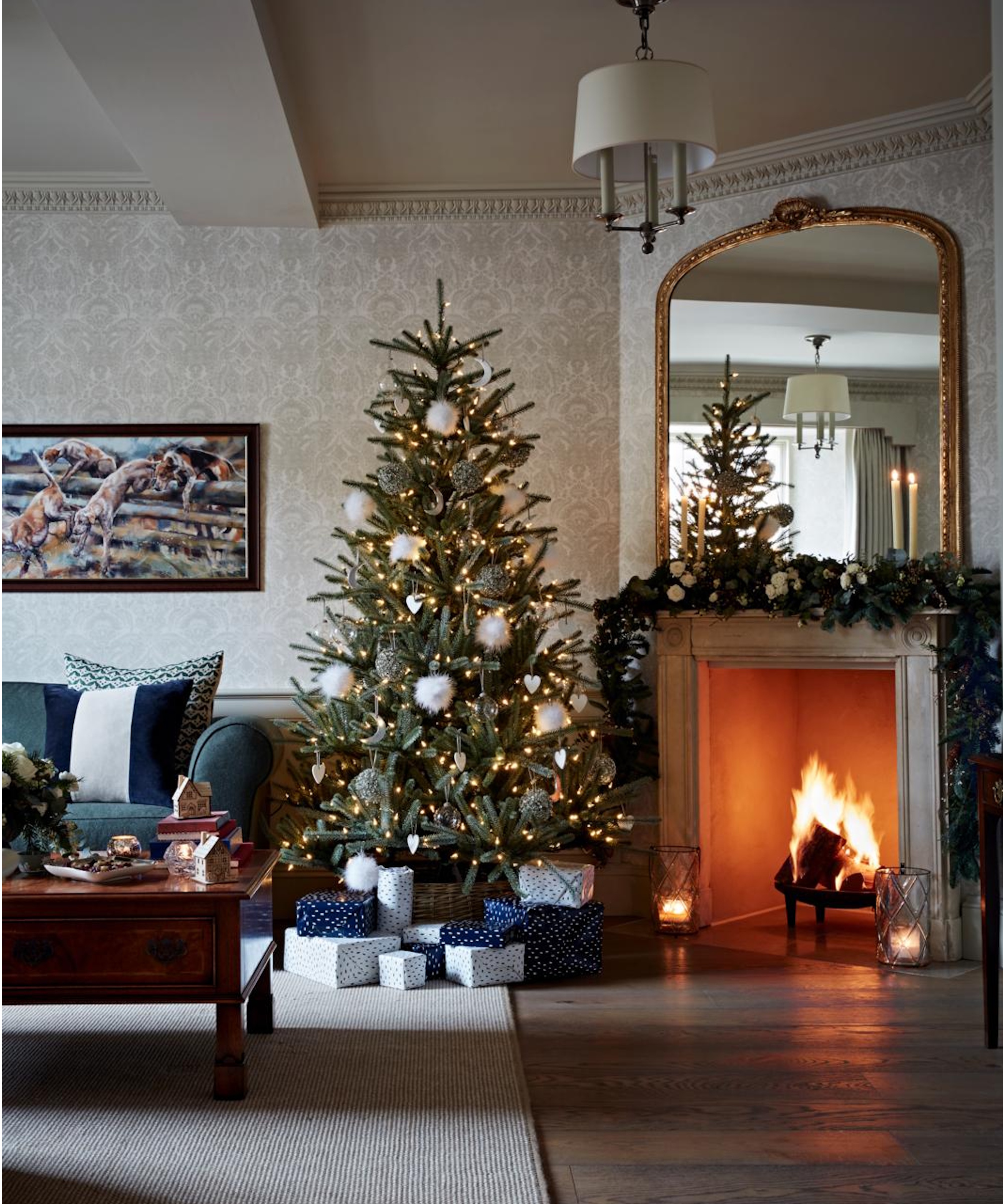
7 steps to caring for a Christmas tree
All of the below expert tips are for real, living Christmas trees, prolonging their display and freshness for the holiday season.
If you have an artificial Christmas tree, our guides to artificial Christmas tree buying mistakes and how to make a Christmas tree look fuller may be helpful.
1. How to choose the right Christmas tree

Picking out a Christmas tree variety each year is a family tradition for many, but take care not to get caught up in the excitement of the Christmas tree farm – it's important to take your time assessing which one is the perfect pick.
'It’s important to choose as fresh a tree as possible’, advises Lisa Tadewaldt, arborist and co-founder of Urban Forest Pro.
Design expertise in your inbox – from inspiring decorating ideas and beautiful celebrity homes to practical gardening advice and shopping round-ups.
How to tell that a tree is fresh? One sign is its weight: ‘The heavier the tree the fresher it is’, says Lisa. So, it can be a good idea to pick up several trees when choosing yours.
Healthy trees will also have a shiny, glossy green coating on the needles which feels slightly waxy to touch. You should also look for strong branches and a good needle retention when choosing a Christmas tree.
You can conduct a simple needle retention test. Simply take the tree by the trunk – you may need to wear gardening gloves with sleeves (from Amazon) to make this more comfortable – and give it a gentle tap on the ground. If any more than a few pine needles fall, then move on to another, healthier specimen.
Pay attention to scent, too. A tree that has the characteristic pine smell still has sap running through it. One that no longer smells of anything is dead before you even put it up in your house.
Another consideration to keep in mind is the size of your Christmas tree. Choosing one too large for your space could result in some pretty hefty pruning, impacting the overall shape of your tree its health.
If you're working with lower ceilings or a smaller room, you might be interested in buying a smaller pot-grown tree instead.
Mini Christmas trees, such as this Dwarf Alberta Spruce from Walmart, are perfect for tabletop decorating, for example. They also make charming additions to children's rooms and entryways, bringing festive cheer to every corner of the home – plus, they can then be grown in the yard afterwards, ready to bring back inside next Christmas.

Lisa Tadewaldt is the co-founder of Urban Forest Pro, a tree care company based in Portland, Oregon, U.S., and an ISA-certified arborist. Lisa has been in the tree care business for over 20 years and has established a great reputation as a tree care expert within the industry.
2. Transporting your Christmas tree home
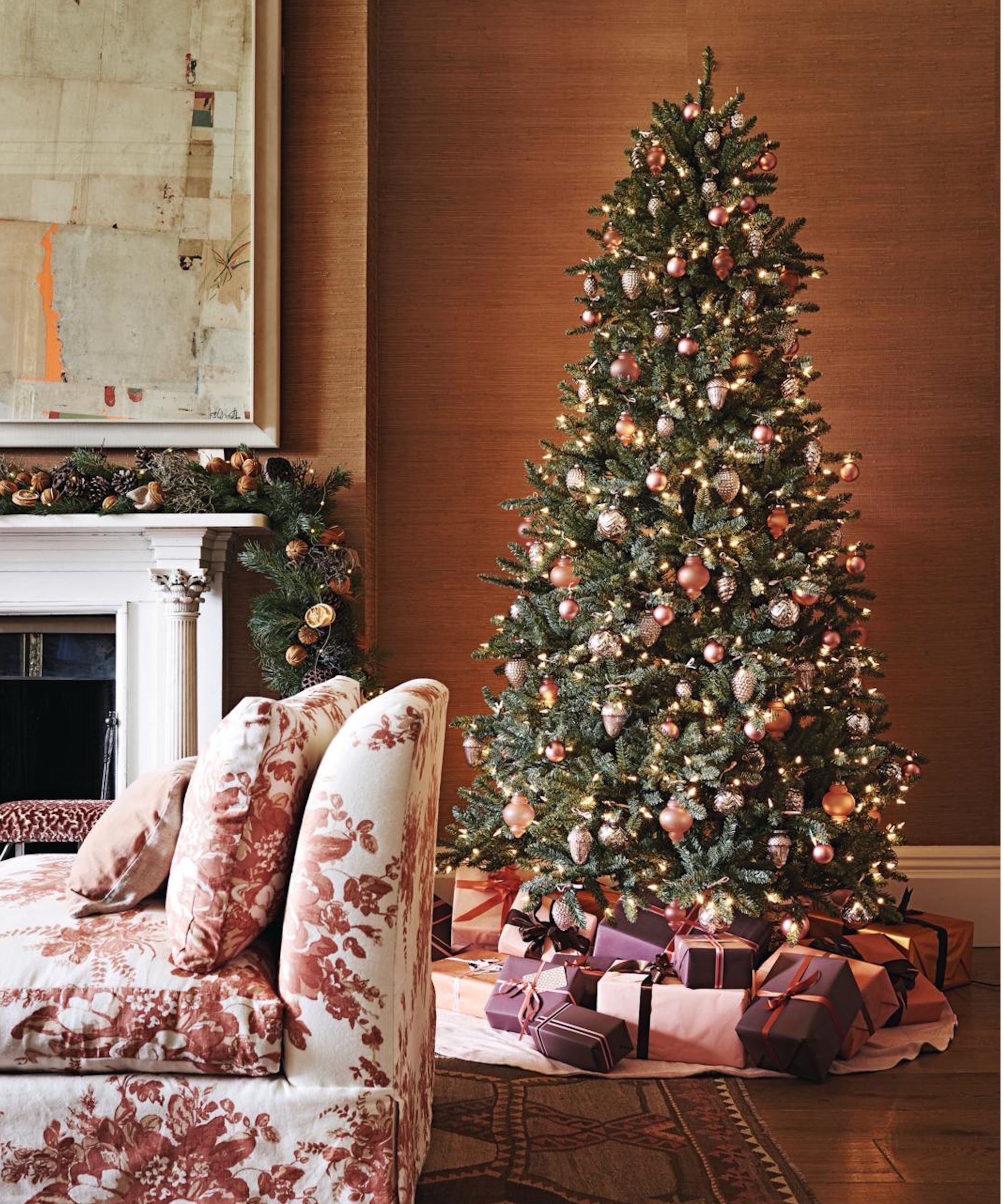
When you're bringing a Christmas tree home, make sure the interior of your car is clear so you'll be able to fit it in.
If the garden center, farm, or market has netting available, always select this option as it helps to protect the tree for the journey. If the tree is going inside, old blankets, a dust sheet or a tarp (from Amazon) will help protect the interior, but can also be useful on the roof to save your car paint from any scratches from the trunk.
If using the roof, of you car, make sure to fasten securely with rope (from Walmart) or bungee cords (from Amazon). The general rule is to use at least three straps to secure your tree in place. Using just one strap is unreliable and risks the tree falling off and becoming hazardous on the road.
The stump of your tree should face forward to protect the foliage and prevent it blocking your vision. It's also wise to use a cargo mesh cover (from Amazon) to protect and secure your tree in transit.
Make sure to also keep your distance from other cars to transport the tree safely.
3. What to do when you get your tree home

When you get your tree home, the first thing to do is remove the netting and leave it outside to stand for 24 hours to allow the branches to settle.
This will also help to acclimatize your tree so that it doesn't instantly drop needles when brought indoors.
What you do next depends on whether you have a cut tree or a potted tree.
For cut Christmas trees, it's wise to saw the bottom of the trunk off.
Lisa Tadewaldt explains that making a fresh cut to the trunk ‘will allow better water uptake for the tree which will help to keep it hydrated.’
Cut trees will attempt to heal the open base, so you may even be tempted to give it another cut just before the big day. This will help it perk up if it's drooping by improving water uptake – just make sure to remove your ornaments beforehand to avoid any breakage.
We recommend using a folding pruning saw (which can be bought on Amazon) for this, as it’s safer and easier to use than an axe.
Then secure it within a sturdy Christmas tree stand, such as this one from Amazon, ideally one with a water reservoir. A Christmas tree skirt or collar will hide this if you would prefer to conceal its appearance.
After your tree is in position, fluff your Christmas tree to help it regain its shape.
As for potted Christmas trees, they will also benefit from a period to settle. When bringing it home, you should also pay some attention to its container.
If poorly containerized, e.g. in a too-small pot, it can be a good idea to repot your Christmas tree to maintain healthy roots. You can use a standard all-purpose well-draining potting mix (from Amazon) for this.
It can also be a good idea to give your potted tree a deep watering to hydrate it after transit.
4. Watering your Christmas tree
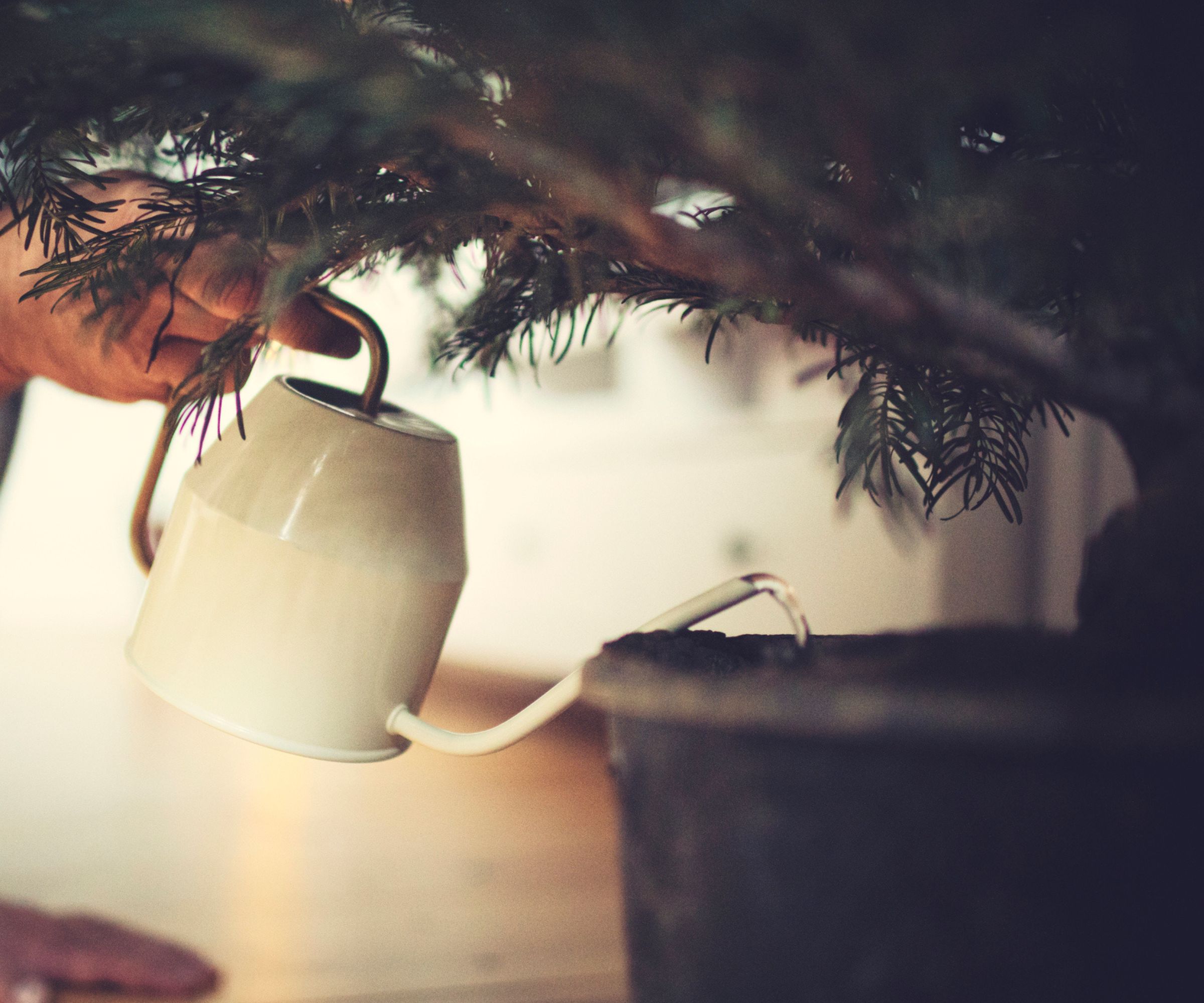
'Trees will drink a lot of water during the first few days in your home, and after that, the tree will level out and drink the water it needs to keep your Christmas tree alive,' says Greg Walsh, Christmas tree expert at Greg's Trees.
For this reason, Greg's golden rule for watering a Christmas tree is, 'make sure the water in the stand is always full.'
Ideally, you should be checking the water level every morning and every evening for the first week, and once a day thereafter. Don’t let the stand ever go empty as this will cause your tree to start dying prematurely.
For a potted tree, moisture management is slightly different, as you don't want to oversaturate the soil and cause root rot.
Use a soil moisture meter (from Amazon) to regularly check the moisture level and top up when the top two inches dry out. Your potted Christmas tree should have a consistent, but not soggy moisture level.
If you can, water your Christmas tree with filtered water or rainwater collected in a water butt or barrel in your yard. Your tree (and houseplants) much prefer rainwater, as tap water contains added minerals which can be harmful to plants.
'During my years as a florist, I learned that you should always water your Christmas tree with hot or warm water, as this will allow the tree to take up water faster and therefore stay better hydrated,' says Rachel Bull, Head of Gardens at Homes & Gardens.
'If you can, score some lines into the sawn off stump of the tree too, as this will also encourage better uptake into the trunk when you water a Christmas tree,' she says.
As for watering potted Christmas trees before going away for the holidays, don't be tempted to oversaturate it. Give it a deep watering and then install a few watering orbs (from Amazon) to keep it hydrated while you're away.
There are also dedicated Christmas tree watering systems available to buy to help with moisture management – like this automatic Christmas tree watering system from Amazon.
'It’s very important to not let the water dry out, because the tree protects itself when it’s not receiving nutrients by sealing itself with sap and it may never open up to receive water again, causing your Christmas tree to droop,' explains Greg.

Greg Walsh has been in the tree business for over 30 years. Starting with a few friends, they brought their passion and love of Christmas to deliver beautiful Christmas trees to NYC.

Rachel is a gardening editor, floral designer, flower grower and gardener. Her journalism career began on Country Living magazine, sparking a love of container gardening and wild planting. After more than a decade writing for and editing a range of consumer, business and special interest titles, Rachel became editor of floral art magazine The Flower Arranger. She then trained and worked professionally as a floral designer. She joined the Homes & Gardens team in 2023, where she heads up the Gardens section, and presents the weekly social series Petals & Roots.
5. How to stop your Christmas tree from drying out
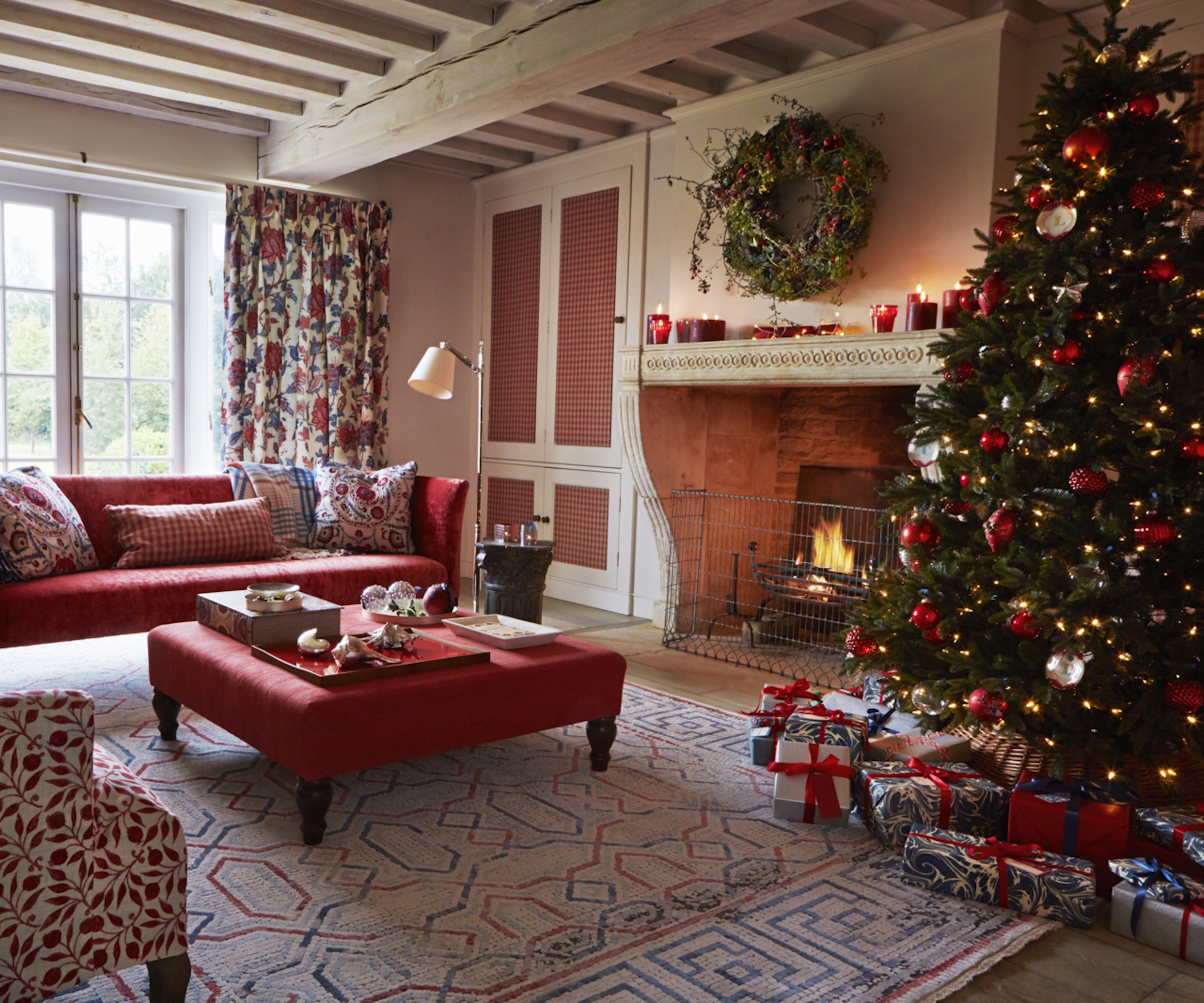
It's a common problem for Christmas trees to dry out if not placed in the right spot and not kept hydrated. When they dry out, they also tend to drop needles more quickly.
'Avoid radiators, fireplaces, or direct sunlight,' advises Andrew St. Clair, arborist from Joshua Tree Experts. 'You should position the tree away from these heat sources to prevent it drying out,' he adds.
Although aesthetically pleasing and no doubt cozy next to a fireplace, pine trees are the most common type of Christmas tree and these frost-hardy plants don't enjoy higher temperatures.
Near an active fireplace, your tree will dehydrate at a faster pace, which can also become a huge fire hazard.
The same goes for placing real candles on your Christmas tree. Although offering a retro look, all it takes is a gentle knock or a gust of wind for your Christmas tree to go up in flames.
'Sudden heat or drafts can cause stress,' Andrew also notes. Even when following Feng Shui Christmas tree placement rules, it's best to choose one permanent spot for your Christmas tree where it isn't exposed to too high or too low temperatures.
The ideal room temperature to keep your Christmas tree is between 65-75°F – use this room thermometer from Amazon to monitor it.
Rachel Bull notes overloading the Christmas tree with lights, which generate heat, will also dry it out faster: 'Smaller, LED lights will give off less heat and slow the drying process.
'I've also had disasters with underfloor heating in the past, which has caused my Christmas tree to droop prematurely,' she adds. 'If you can lower the thermostat, or even survive without putting the underfloor heating on in the room where your tree is, this will really help to keep it looking fresh and healthy.'
Spraying your tree with room-temperature water at least once a day will also aid hydration and make your tree more fire-resistant (remember to only do this when the Christmas lights are off and unplugged).
Placing a humidifier (from Amazon) in the room where the tree is located can help maintain an optimal moisture level in the air around the tree, too. You can also try other methods used to increase humidity for indoor plants, like placing other plants near your Christmas tree,
Don't forget to also avoid a direct sun position, which can leaf scorch and turn your Christmas tree brown. But, if you're trying to make a Christmas tree fit in a small space and by a bright window is your only option, consider investing in some self-adhesive window film, such as this heat reflective window film from Amazon.
6. How to keep your Christmas tree smelling fresh

A cut Christmas tree can drink up to two pints of water a day depending on its size, however, if your tree doesn’t seem to be taking as much in, then stagnant water could be the source of the foul smell around your Christmas tree.
When watering a Christmas tree, keep an eye on the water level to make sure it is being absorbed before topping it up. If you notice the water level isn't dropping after a day or so, it may be that the base of your tree has been sealed over by tree sap or resin, causing water to become stagnant and smelly.
There are a few things you can do. First, adding two to three tablespoons of plain white vinegar (from Walmart) can help to neutralize the smell of stagnant water and kill water-borne bacteria without harming a tree.
If the smell has not dissipated after a few days, then you may need to drain the reservoir completely and exchange the old water for a fresh supply.
Observe the bottom of your tree's trunk when doing this. If it has sealed over, make a fresh cut with a pruning saw (from Amazon) to improve water uptake.
If any sap has made its way onto your floor during this process, our guide to cleaning up Christmas tree sap and resin can help.
Another cause of the smell may be mold. This is a likely cause if your home is very humid and you regularly spritz your Christmas tree foliage.
Luckily, you can get rid of mold fairly easily, by once again using plain vinegar to wipe down foliage.
Consider also putting a dehumidifier (from Amazon) in place to help control humidity levels going forward.
7. What to do with your Christmas tree after the holidays
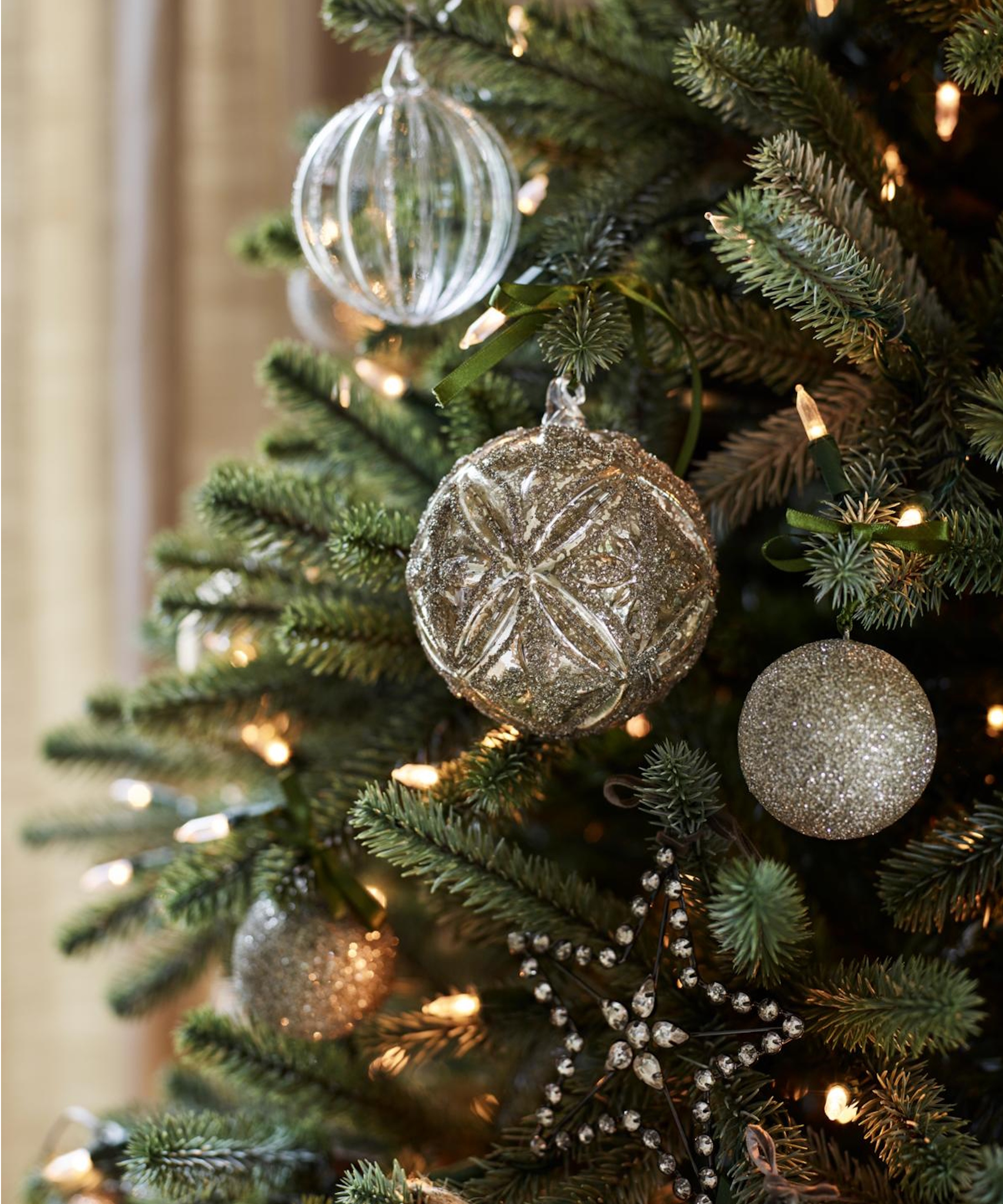
Once Christmas is over, it's time to think about taking the tree and Christmas decorations down and decide what to do with your tree.
When it comes to knowing how to dispose of a Christmas tree, our favorite thing to do is to recycle it. Check if there are any doorstop collections in your area or use the tree for compost or mulch in your yard.
'To use a Christmas tree for mulch, you'll need to shred the tree up into woodchips,' explains Rachel Bull. 'Pine needles are also a valuable material for mulch and will help with suppressing weeds, as well as retaining moisture,' she adds.
There are a few ways to shred your Christmas tree. You can use a wood chipper, available at Amazon, or opt for using essential gardening tools like this hand saw from Amazon.
For the wildlife garden-lovers, you can reuse your Christmas tree in your yard by making a wildlife log pile, providing essential shelter for a range of small mammals and beneficial insects.
'Cut your Christmas tree up and make a pile of the matter in your yard. Leave it undisturbed and you'll observe insects, hedgehogs, and even frogs use it for shelter,' Rachel says.
With pot-grown trees, these can be planted out in January. If that’s your plan, check the requirements of the specific tree species you have to be sure you can provide the right growing environment for it.
You may also want to bring the Christmas tree inside again next year, and if that’s the case, don’t plant it out. Instead grow it in a container, increasing the size of pot roughly once a year to accommodate its growing size.
FAQs
Does hairspray stop pine needles from dropping off a Christmas tree?
The short answer is yes, but it isn't necessarily the best thing to do. Greg Walsh, Christmas tree expert at Greg's Trees warns the hairspray trick 'turns your Christmas tree into an extreme fire hazard'. For that reason alone Greg does not recommend using hairspray to preserve your tree. Instead, he says to focus on keeping it well-hydrated, the number one way to stop needles from dropping.
Should you add preservatives to Christmas tree water?
Greg Walsh, Christmas tree expert at Greg's Trees recommends using a special tree preserver (like this from Amazon). It creates a gel around the trunk, retaining moisture and keeping the tree hydrated. Other types of Christmas tree preservative hacks are not necessarily advised.
A report from Michigan State University Extension advises against adding anything to your tree's water. 'Do not add sugar, aspirin, bleach or floral preservatives. Research has shown plain tap water is all that is needed to keep your tree fresh', cautions the report.
How can I keep my cats away from the Christmas tree?
You can use a scent that cats cannot stand to stop them getting too close to your Christmas tree. Josh Wiesenfeld, founder of Boxie cat litter, has insight into why this works:
'Just a few drops of lemon or orange essential oil (from Amazon) with water, sprayed lightly on the branches, does the trick. Cats are notorious in their dislike for citrus scents. It's essential that you spray lightly so it doesn't overpower your space,' he notes.
You can also try placing pine cones sprayed with rosemary or eucalyptus oil around and in your tree. It not only keeps cats away from your Christmas tree, but also adds a pleasant seasonal scent to the space.
Make sure to also place dangling ornaments higher up on your tree, so your cats aren't tempted to play with those hanging at a lower level.
Now you're clued up on the best ways to care for a Christmas tree, you can get inspired with our ideas on how to decorate a Christmas tree. Plus, if you have limited room to work with, you can still get super creative with our expert style advice on how to decorate a small space for the holidays.
Timeless Christmas tree accessories

Tenielle is a Gardens Content Editor at Homes & Gardens. She holds a qualification in MA Magazine Journalism and has over six years of journalistic experience. Before coming to Homes & Gardens, Tenielle was in the editorial department at the Royal Horticultural Society and worked on The Garden magazine. As our in-house houseplant expert, Tenielle writes on a range of solutions to houseplant problems, as well as other 'how to' guides, inspiring garden projects, and the latest gardening news. When she isn't writing, Tenielle can be found propagating her ever-growing collection of indoor plants, helping others overcome common houseplant pests and diseases, volunteering at a local gardening club, and attending gardening workshops, like a composting masterclass.


